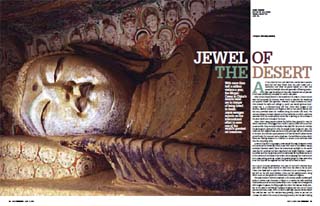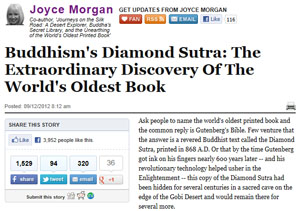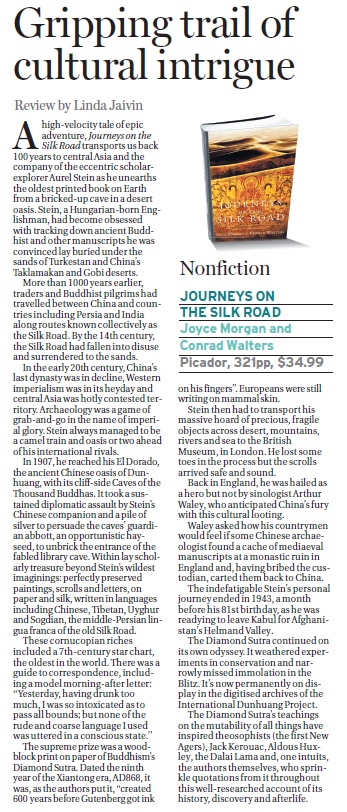
The world’s oldest printed book was hidden for more than a thousand years in a Buddhist meditation cave on the edge of the Gobi Desert. Joyce Morgan, with co-author Conrad Walters, tells the epic tale behind its remarkable discovery.
The Extraordinary Discovery Of The World’s Oldest Book
By Joyce Morgan Huffington Post 12 September 2012
Ask people to name the world’s oldest printed book and the common reply is Gutenberg’s Bible. Few venture that the answer is a revered Buddhist text called the Diamond Sutra, printed in 868 A.D.
Or that by the time Gutenberg got ink on his fingers nearly 600 years later — and his revolutionary technology helped usher in the Enlightenment — this copy of the Diamond Sutra had been hidden for several centuries in a sacred cave on the edge of the Gobi Desert and would remain there for several more.
Read full article
Conversations with Richard Fidler, ABC Radio
Presented by Richard Fidler ABC Radio 12 July 2011
Richard Fidler: Today you’re going to hear the story of a real-life Indiana Jones, a secret library and the world’s oldest printed book that was found inside it. My guests are two people who have literally been on the trail of this story, Joyce Morgan and Conrad Walters. They’re both journalists with The Sydney Morning Herald. They’re a married couple. And in their home in Sydney, on the mantelpiece, they keep a little vial of sand. And this sand is from the Taklamakan Desert in outer western China.
And that’s where today’s story comes from. This desert was one of the most dangerous parts of the Silk Road, a road that was trod by Alexander the Great and served as a trading route between the Roman Empire and China. This is a part of the world with insanely exotic place names: the city Kashgar, the Thieves’ Road, the salt lake of Lop Nor and the Caves of the Thousand Buddhas.
And it was in these caves a century ago that a Chinese monk found the entrance to a secret library that had been sealed up for more than a thousand years. And in that library he found the Diamond Sutra, an ancient book that has inspired Jack Kerouac and the Dalai Lama.
Hear full interview (50 minutes)
Review: Gripping tale of cultural intrigue
Review by Linda Jaivin The Sydney Morning Herald, Spectrum 9 July 2011
A high-velocity tale of epic adventure, Journeys on the Silk Road transports us back 100 years to central Asia and the company of the eccentric scholar explorer Aurel Stein as he unearths the oldest printed book on Earth from a bricked-up cave in a desert oasis. Stein, a Hungarian-born Englishman, had become obsessed with tracking down ancient Buddhist and other manuscripts he was convinced lay buried under the sands of Turkestan and China’s Taklamakan and Gobi deserts.
More than 1000 years earlier, traders and Buddhist pilgrims had travelled between China and countries including Persia and India along routes known collectively as the Silk Road. By the 14th century, the Silk Road had fallen into disuse and surrendered to the sands.
In the early 20th century, China’s last dynasty was in decline, Western imperialism was in its heyday and central Asia was hotly contested territory. Archaeology was a game of grab-and-go in the name of imperial glory. Stein always managed to be a camel train and oasis or two ahead of his international rivals.
Read full review
Valley of the lost scrolls

By Joyce Morgan
The Sydney Morning Herald, Traveller
25 June 2011
The camel man drops to his knees. Until now Mr Liu has shown no sign of tiring. Indeed he has belted out song after song as he has walked ahead of me through the towering dunes of the Gobi Desert.
And then he begins burrowing. There’s nothing to mark this spot other than a solitary bush a few metres away. But minutes later he uncovers from the sand a black plastic bin liner. He pulls out of it a camp chair. Then another.
After just a few hours, I’m relieved to have something more forgiving to sit on than a saddle lashed between the twin hairy humps of a Bactrian camel. In the desert, where there’s rarely even a scrubby bush to lean on, a battered folding chair is a luxury. I realise how the loss of a camp chair must have irked the trailblazing desert traveller Aurel Stein, the British-Hungarian explorer and archaeologist whose footsteps I’m tracing, when he dropped it in this region a century ago.
See full article
ABC Radio National: The Book Show
Presented by Ramona Koval
ABC Radio
28 June 2011
Ramona Koval: The story of the discovery is a great, epic tale, and we’re going to talk about that shortly, but how did your interest in the Diamond Sutra get piqued?
Joyce Morgan: I tripped over the story, in a way. I was in Los Angeles at the Getty Museum, where I was looking around the Conservation Department, and we walked past a computer screen and somebody said to me, “Oh, that’s some work we’re doing in the Gobi Desert, some conservation work”. And the image of the caves, just captivated me. And I thought, I’ve just got to go there.
Hear full interview (20 minutes)
Jewel of the Desert

By Joyce Morgan
Good Weekend magazine, The Sydney Morning Herald
12 April 2008
At the dawn of the last century, a monk was clearing sand that had been blown from the Gobi Desert into a meditation cave when his glance lighted on a wall. Just across the threshold, where sun gave way to flickering lantern light, was the outline of a doorway. Plastered over and painted, it had been deliberately concealed for nearly 1000 years.
What he had already found in the honeycomb of caves in China’s remote west had prompted the itinerant Taoist monk to abandon his wandering and appoint himself their guardian. Frescoes in lapis, turquoise and malachite covered the walls and ceilings in nearly 500 temple grottoes hand carved into a 1.6-kilometre-long cliff face.
There were images of the Buddha, celestial musicians and angels, as well as 2500 saintly statues that had once provided solace for travellers along the ancient Silk Road. The contrast between the desert beyond and the meditative art within must have resonated with the contemplative monk; like a teaching on the aridness of the outer world and richness of the inner.
A hidden world of priceless knowledge

By Joyce Morgan
The Sydney Morning Herald, News Review
4 June 2011
The librarian presents a written statement and asks me to read it aloud. I clear my throat and recite the paragraph. I promise not to mark, deface or injure anything. And I promise not to smoke or kindle any fires. If only Julius Caesar had taken such an oath, the great library at Alexandria might still be standing. The pledge is one all must utter before admission to Oxford’s Bodleian Library.
There is a history of the destruction by fire of the world’s great libraries, either by accident — step forward, Caesar — or design. India’s great monastic library Nalanda burnt for three days after it was torched by 12th-century Islamic invaders.
Perhaps never before have books been consigned to storage or scrapped by their custodians, yet that is the Sophie’s choice increasingly facing libraries, institutions on the frontline of the digital age.
See full article
My, how you have changed
By Joyce Morgan
The Sydney Morning Herald, Spectrum
30 August 2008
There are moustached Buddhas, hollow-cheeked, starving Buddhas, jolly, big-bellied ones and slim smiling figures. The Buddha is nothing if not adaptable. As the religion spread across Asia from its birthplace in northern India about the 5th century BC, the Buddha has taken on the features of those it has encountered.
The Buddha grew a moustache, put on sandals and developed rippling muscles as he appeared in Gandhara, present-day Pakistan and Afghanistan. These Buddhas resemble ancient Greek or Roman gods and reflect the impact on the region of the conquest by Alexander the Great.
As Buddhism entered China, probably via the Central Asian Silk Road about the 2nd century, the early images still looked distinctly Greco-Roman. But the imported style of the Gandharan-influenced Buddhas was gradually supplanted by a home-grown look. A Chinese style emerged with sinocised features and courtly robes by about the 5th century.
Sutra Karma

By Rosemarie Milsom
The Newcastle Herald, Weekend Magazine
30 July 2011
While being shown around the J. Paul Getty Museum’s conservation department during a three-week fellowship at the magnificent Los Angeles institution in 2005, arts journalist Joyce Morgan spotted an image on a computer screen.
“There were van Goughs out of their frames and artwork everywhere,” she remembers. “We walked past this computer and the guide said to me, ‘That’s some conservation work we’re doing at these Buddhist caves in the Gobi Desert’. That pushed all my buttons.”
The intrepid traveller, who enjoys the solitude of deserts and had previously visited exotic and isolated Central Asia, had never heard of the Caves of the Thousand Buddhas, a holy site of more than 400 caves hewn out of the granite cliff near Dunhuang in north-west China. Morgan felt compelled to learn more about their discovery, and in 2007 set off to the edge of the Gobi desert to write a feature about their conservation.
Books in Brief, Fall 2012
Review by Emma Varvaloucas
Tricycle magazine
11 August 2012
“What would it have been like if Indiana Jones had gone on a Buddhist adventure? Journeys on the Silk Road, from Australian journalists Joyce Morgan and Conrad Walters, gives us an idea…
“It’s certainly a story worth Steven Spielberg’s attention (and moreover, it’s historically true), but in reality [explorer Aurel] Stein resembles the monks whose paths he devotedly followed more than he does any dashing Harrison Ford character… Still, Journeys on the Silk Road is written with such color that the expansive history covered in the book, from early European Buddhist scholarship to debates over modern-day translations of the Diamond Sutra, is as exciting as a trip to the movies.”
Read full review
Nonfiction review: Journeys on the Silk Road

Review by Publishers Weekly
6 August 2012
“Morgan and Walters’s narrative is a captivating biography of the intrepid [Aurel] Stein, an intriguing history of the Sutra and the political and social upheavals that surrounded it, and an enthralling travelogue in its own right…
“Both experienced journalists, the authors do an impeccable job of bringing readers into the action and situating the story in a broader–though no less riveting–historical context.”
Read full review
Editor’s Choice – Media Review
Review by Laura Miller
Mandala magazine
October 2012
Morgan and Walters’ book becomes a page-turner as the journalist-authors’ unfold the story of Aurel Stein as a real-life Indiana Jones. Stein, who took detailed notes on his expeditions, provides the book’s colorful and fascinating details of his months-long and often grueling travels along ancient trade routes.
Stein’s 1906-1908 expedition through Turkestan is the focus of Journeys on the Silk Road. On it, Stein traveled to Dunhuang, China, and visited the Caves of the Thousand Buddhas where he had heard that a huge cache of old scrolls had recently been discovered. This cache turned out to be a remarkable collection of more than 40,000 ancient texts — a major archeological find that is actively being studied by scholars today.
Read full review






